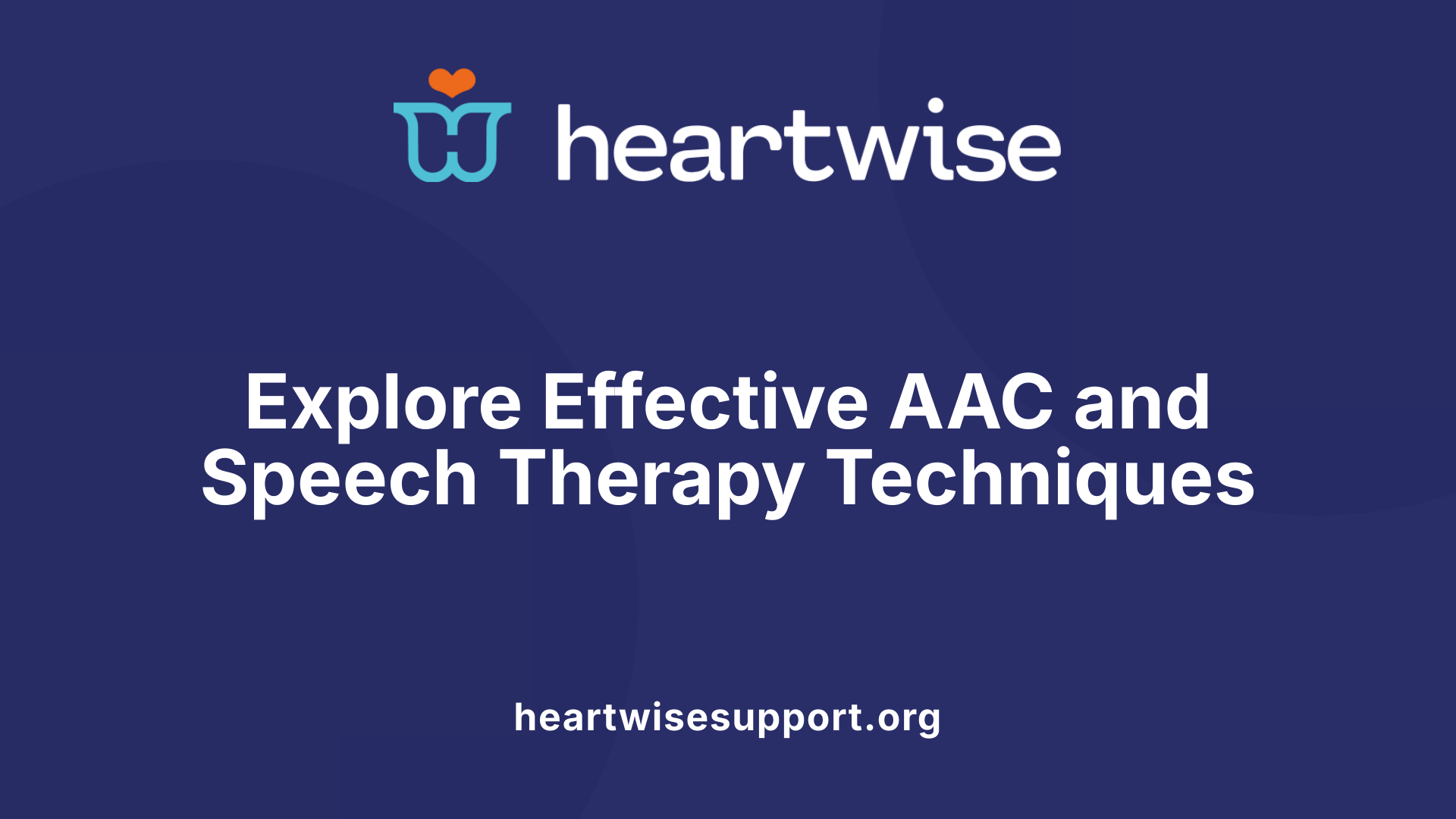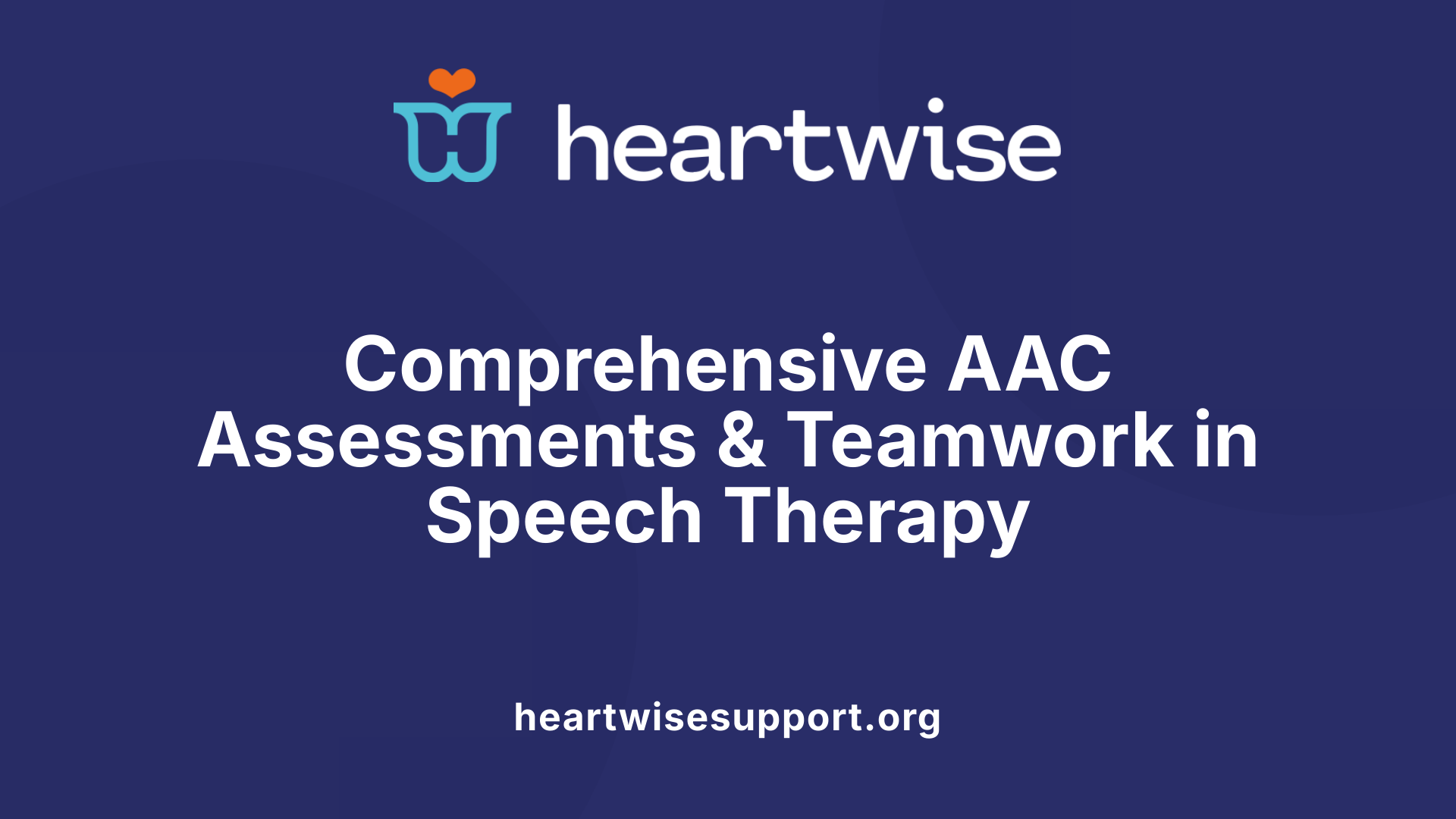Understanding the Foundations of Communication Support
Communication is a fundamental human need, yet for many individuals with speech and language impairments, expressing themselves can be a significant challenge. Speech therapy and augmentative and alternative communication (AAC) systems have revolutionized the way these individuals engage with their environment, fostering independence, social participation, and improved quality of life. This article explores the various methods, tools, and considerations involved in speech therapy and AAC, aiming to provide a comprehensive understanding of their roles in supporting diverse populations.
Overview of Speech Therapy and AAC Methods

What are examples of augmentative and alternative communication (AAC)?
Examples of augmentative and alternative communication (AAC) include both unaided and aided methods that help individuals communicate effectively. Unaided AAC involves gestures, facial expressions, manual signs, body language, and vocalizations that do not require external tools. Aided AAC, on the other hand, uses external supports such as communication boards, picture exchange systems (PECS), letter or communication books, and electronic devices like tablets, speech-generating devices, or apps. These devices can range from no-tech options like picture cards to high-tech electronic speech output systems that can be customized to individual needs.
The selection of AAC methods depends on the person's abilities, preferences, and environment. Speech-language pathologists (SLPs) play a vital role in guiding individuals and their families in choosing and mastering the most suitable AAC tools to enhance communication skills.
What are common AAC devices and tools used for speech and communication?
Common AAC devices include electronic speech-generating devices such as tablets, laptops, and specialized communication devices like NovaChat, Tobii Dynavox, and Pocket Go-Talk. These devices are equipped with customizable vocabularies, large-sized buttons, eye-tracking technology, and text-to-speech features to facilitate effective communication.
In addition to electronic systems, aided AAC tools include communication boards, symbol charts, alphabet boards, and printed communication books. These resources offer visual, tactile, and sometimes auditory supports to express needs, ideas, and feelings.
Non-electronic methods also serve as AAC strategies and include gestures, facial expressions, sign language (like American Sign Language or Makaton), and writing. Speech-language pathologists assist users in selecting, introducing, and teaching the most effective tools and methods based on individual abilities and goals.
What are speech-generating devices and how do they support communication?
Speech-generating devices (SGDs) are electronic tools designed to support individuals with significant speech impairments by producing spoken language through synthesized or recorded voices. These devices range from dedicated hardware to software applications installed on smartphones and tablets.
SGDs are highly customizable, allowing users to choose vocabulary, input methods such as touchscreens, switches, or eye gaze, and speech output options. They help users express their thoughts, participate in conversations, access education, and engage socially, thereby reducing feelings of isolation.
Proper training in the use of SGDs, provided by speech-language pathologists, is essential to maximize their benefits. These devices often form part of a comprehensive AAC system tailored to the individual's communication needs.
How is AAC evaluated in speech therapy?
Evaluation of AAC in speech therapy involves a thorough process conducted by a speech-language pathologist. The goal is to identify the most suitable communication system rooted in the individual's abilities and preferences. The assessment includes reviewing medical history, current speech, language, cognitive, motor, vision, and hearing skills, as well as environmental factors.
Therapists observe the individual's current communication methods and trial various AAC options, such as picture symbols, communication boards, speech-generating devices, or specialized access methods like eye gaze or switches.
The evaluation aims to determine appropriate vocabulary, system layout, and training needs for users and communication partners. Continuous assessment allows for adaptation of the AAC system over time, ensuring it remains effective as the individual’s needs evolve.
What are the components of AAC according to speech therapy principles?
In line with speech therapy practices, AAC components are often described using the four Ps: paper, powered, person, and partner. These represent the physical tools (paper-based aids or powered electronic devices), the individual user (person), and the communication partner (family, caregivers, teachers).
AAC components also include both unaided methods—such as gestures, signs, and facial expressions—and aided methods like communication boards, symbol systems, and electronic devices.
Speech-language therapists provide assessment, recommendations, and support to integrate these components effectively, taking into account cultural, linguistic, and personal preferences. Ongoing training, collaboration with multidisciplinary teams, and environmental modifications are essential for successful AAC implementation.
The Role of Speech-Language Pathologists in AAC Implementation

How can AAC devices support individuals with autism?
AAC devices serve as vital tools for individuals with autism, especially those who are nonverbal or have speech that is limited or difficult to understand. These devices offer alternative ways to communicate, enabling users to express needs, feelings, and thoughts more effectively. They foster social engagement, reduce frustration, and promote independence by providing customizable options like symbols, words, and phrases tailored to the individual’s preferences. Many AAC devices feature advanced capabilities such as eye tracking, facial recognition, and video modeling, which support learning life skills and encouraging social interactions.
Whether portable or durable, these devices are designed to be user-friendly across different environments—from home to school to community settings. They are suitable for users of all ages, helping to bridge communication gaps and improve quality of life. Overall, AAC devices are essential for empowering individuals with autism, fostering better relationships, and supporting emotional and social development.
What are common myths and misconceptions about AAC and speech therapy?
Many misconceptions surround AAC and speech therapy, which can sometimes hinder their effective implementation. A prevalent myth is that using AAC devices prevents or hinders the development of spoken language. In reality, research demonstrates that AAC can support and even enhance speech development when integrated properly. Another misconception is that AAC is only useful for children or the elderly; in truth, people of all ages, including teenagers and adults, benefit from AAC systems adapted to their needs.
Some assume that AAC should be tried only after traditional speech therapy has been exhausted or that only low-tech options, like communication boards, should be used initially. However, current practices support early introduction of various AAC tools—including high-tech devices—based on individual preferences and abilities. Others believe that AAC users must be fully independent or possess certain prerequisite skills, which is false. Many individuals require support from communication partners, and skills are often developed through ongoing use of AAC systems.
There is also a misconception that AAC is only suitable for those with the most severe impairments. Yet, it is a flexible, versatile solution that benefits a wide spectrum of abilities and conditions. Understanding and dispelling these myths is essential to ensuring that individuals who could benefit from AAC receive support and resources to maximize their communication potential.
How do speech-language pathologists support AAC users?
Speech-language pathologists (SLPs) play a central role in the successful implementation of AAC systems. Their work begins with comprehensive assessment—evaluating an individual's speech, language, cognitive abilities, motor skills, hearing, vision, and current communication methods. This evaluation guides the selection of the most appropriate AAC tools and strategies tailored to each person’s unique needs.
SLPs assist in personalized system selection, which can range from no-tech methods like gestures and sign language to high-tech devices such as speech-generating tablets. They oversee device setup, customization, and programming to ensure the system aligns with the user’s vocabulary, motor skills, and cognitive level.
Training is a critical component; SLPs teach users how to operate their AAC devices effectively and support communication partners—family members, caregivers, teachers, and peers—to facilitate consistent use across environments. They provide ongoing support, monitor progress, and make system modifications as the individual develops new skills or requirements change.
By fostering collaboration within multidisciplinary teams—including occupational therapists, physical therapists, educators, and medical professionals—SLPs help create a supportive environment for AAC users. Their expertise ensures that communication is maximized, functional, and integrated into daily life, ultimately enabling individuals to participate more fully in social, educational, and community activities.
How can multidisciplinary teams collaborate effectively?
Effective AAC implementation relies on a coordinated team approach that includes speech-language pathologists, occupational therapists, physical therapists, educators, families, and healthcare providers. By working together, these professionals ensure comprehensive assessment, appropriate system selection, and consistent support.
Regular communication among team members helps tailor AAC strategies to the individual's evolving needs. Occupational and physical therapists contribute insights into motor access and physical environmental modifications, while educators provide feedback on communication in classroom settings.
Family involvement is crucial; caregivers are trained to support AAC use at home, reinforce communication goals, and provide feedback on progress. Ongoing training and support help foster confidence and independence for the user and all involved.
This collaborative approach ensures that AAC systems are integrated seamlessly into all areas of life, promoting social participation, literacy development, and overall functional communication. By embedding AAC into everyday routines and environments, teams create a supportive framework that enhances the quality of life for individuals with communication challenges.
Assessment Procedures and Multidisciplinary Collaboration

What should be included in an AAC assessment checklist?
An AAC assessment checklist is a comprehensive tool designed to evaluate an individual's communication needs, skills, and abilities. It typically includes several critical components. First, it assesses speech and language development, noting current abilities and deficits in expressive and receptive communication. Cognitive and motor skills are also evaluated to ensure the individual can physically access and operate AAC systems. The assessment examines existing communication methods, such as gestures, vocalizations, or gestures.
Environmental factors are a key focus, including the setting where communication occurs, the availability of supports, and the attitudes of communication partners. Understanding the individual's interests and preferred topics helps tailor the AAC system for relevance and motivation. The checklist captures how well current strategies work and identifies areas for improvement.
Input from a multidisciplinary team—including speech-language pathologists, educators, occupational therapists, family members, and the individual—is essential. Their collective insights lead to a nuanced understanding of needs. Practical tools like protocols or evaluation forms standardize data collection during initial and follow-up assessments, promoting consistent and thorough evaluations.
Future Directions and Research in AAC and Speech Therapy
What are current developments in AAC technology?
Recent innovations in augmentative and alternative communication (AAC) technology are transforming how individuals with speech and language challenges communicate. Advanced speech-generating devices now feature naturalistic speech synthesis that sounds more human-like, improving the clarity and expressiveness of communication.
Emerging tools include eye-tracking technology and brain-computer interfaces, allowing users with severe motor impairments to communicate via gaze or neural signals. Apps such as Linggo utilize artificial intelligence (AI) to learn and adapt to users’ language patterns, encouraging vocal speech and enhancing language development. Similarly, apps like LAMP Words for Life leverage motor learning principles to facilitate smoother navigation through vocabulary.
The widespread adoption of tablets, smartphones, and microcomputers has made AAC more portable, affordable, and customizable. Users can personalize devices with preferred symbols, voices, and layouts, making communication more natural and efficient. Ongoing research aims to develop systems that deliver more seamless, realistic, and contextually appropriate interactions, supporting a broad range of populations, including those with complex sensory, motor, or cognitive needs.
What emerging approaches are shaping the future of AAC and speech therapy?
The future of AAC emphasizes naturalistic and goal-oriented strategies that promote spontaneous, meaningful language use in everyday settings. Dynamic assessment techniques now enable clinicians to evaluate users' communication skills in real-time, adjusting strategies accordingly.
Multimodal communication training integrates signing, gestures, speech, and device use, encouraging flexible and spontaneous expression. The integration of AAC with mainstream technologies—such as social media, virtual reality (VR), and augmented reality (AR)—opens new avenues for social participation and engagement.
Innovations include wearable devices that can detect physical cues or neural signals, VR environments that simulate real-world interactions, and AR overlays that enhance communication cues in natural contexts. Machine learning algorithms embedded within AAC systems are increasingly personalized, enabling devices to adapt over time according to individual behaviors and preferences, fostering greater independence.
These approaches aim to make AAC systems more intuitive, user-friendly, and reflective of natural conversation, ultimately supporting a wider range of users and situations.
What is the evidence supporting the effectiveness of AAC interventions?
A robust body of research supports the positive impact of AAC interventions on communication abilities and quality of life. Studies demonstrate that AAC does not hinder speech development; instead, many users experience modest improvements in verbal language, vocabulary, and literacy skills over time.
Social participation is markedly enhanced as AAC reduces frustration and enables users to engage more fully with peers, family, and community members. Early assessment and intervention are critical, as they maximize positive outcomes through personalized system selection and ongoing modifications.
Effective AAC interventions often involve collaborative efforts among speech-language pathologists, family members, educators, and peers. Continual technological advancements, paired with evidence-based practices, ensure that AAC systems remain relevant, capable, and supportive of users’ evolving needs.
Overall, the growing research evidence underscores AAC’s essential role in empowering individuals with communication difficulties, promoting integration, independence, and improved well-being.
Empowering Communication for a Brighter Future
In conclusion, speech therapy and AAC form a comprehensive framework that supports effective communication for individuals facing speech and language challenges. From tape-based communication boards to sophisticated speech-generating devices, the tools and techniques available today are diverse and adaptable to individual needs. The role of speech-language pathologists remains central in assessing, selecting, and training users on these systems, ensuring they are personalized, culturally sensitive, and environmentally supported. As technology continues to evolve—integrating artificial intelligence, virtual reality, and seamless connectivity—future advancements promise even greater accessibility and naturalistic communication experiences. Ultimately, the goal remains steadfast: empowering individuals to communicate freely, participate fully in their lives, and realize their potential for independence and social fulfillment.
References
- Augmentative and Alternative Communication (AAC) - ASHA
- Augmentative and Alternative Communication (AAC) - ASHA
- Augmentative and alternative communication (AAC) overview - RCSLT
- Augmentative and Alternative Communication (AAC) - UR Medicine
- Augmentative and Alternative Communication | Duke Health
- Augmentative & Alternative Communication | Midwestern University ...
- What is AAC (Augmentative and Alternative Communication)? - NAPA











